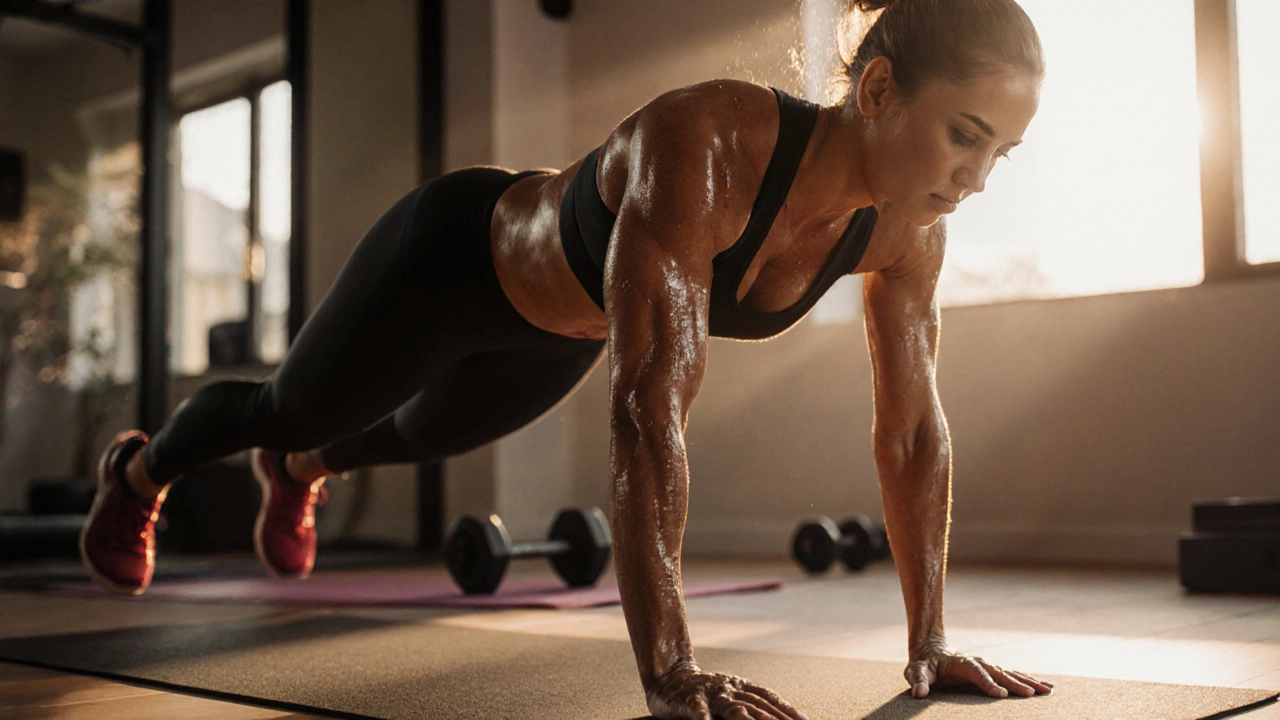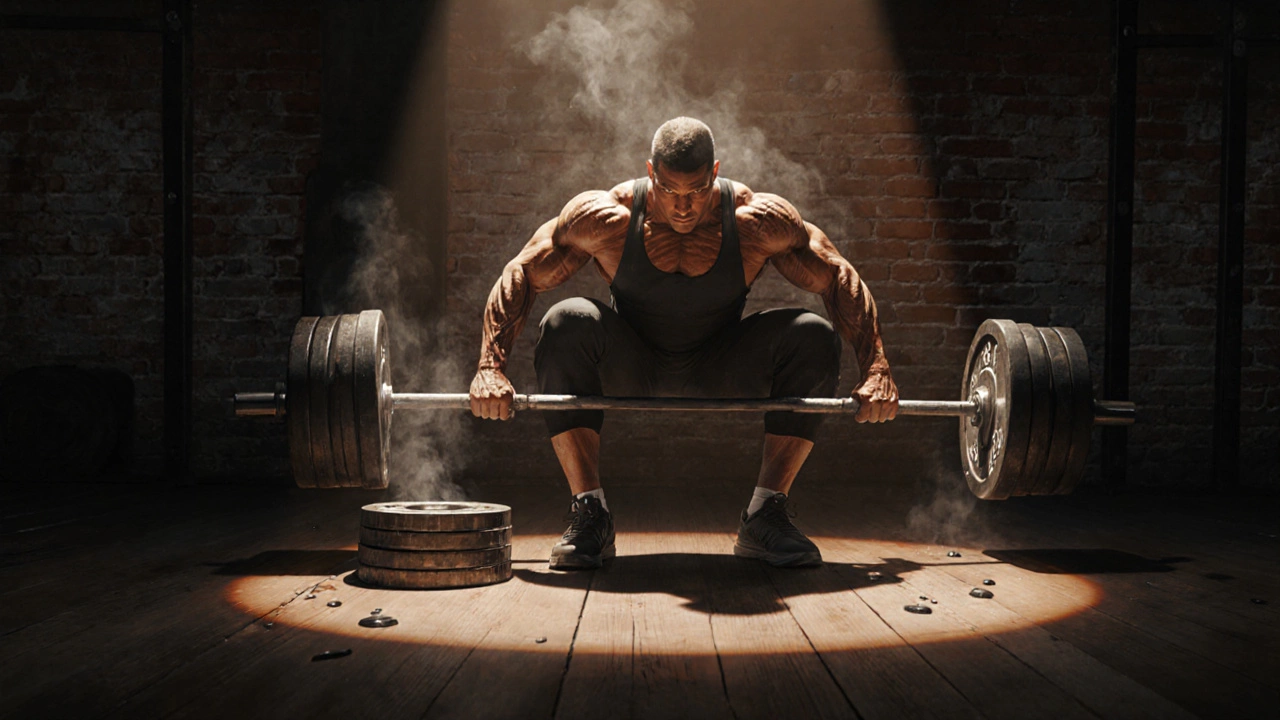What Is Better, HIIT or Weights? The Real Difference for Fat Loss and Muscle Gain

Fat Loss & Muscle Gain Calculator
Recommendation
If you’ve ever stood in front of a gym mirror wondering whether to burn calories fast with HIIT or build strength with weights, you’re not alone. The debate between high-intensity interval training and traditional weightlifting isn’t just about trends-it’s about what actually works for your body, goals, and lifestyle. And the answer isn’t as simple as picking one over the other.
What HIIT Actually Does to Your Body
HIIT-high-intensity interval training-means short bursts of all-out effort followed by brief rest. Think 30 seconds of burpees, then 15 seconds of walking. Repeat that cycle 6-10 times. A typical session lasts 20 minutes. That’s it.
What happens during those 20 minutes? Your heart rate spikes, your muscles scream, and your body burns through stored glycogen fast. But here’s the kicker: the real magic happens after you stop. Your metabolism stays turned up for hours. This is called EPOC-excess post-exercise oxygen consumption. Studies show HIIT can burn up to 25-30% more calories post-workout than steady-state cardio.
One 2023 study from the University of Bristol tracked 80 adults doing either HIIT or moderate cardio five times a week for 12 weeks. The HIIT group lost 2.5% more body fat, even though they trained 40% less time. That’s not a fluke. It’s physiology.
But HIIT doesn’t build muscle. Not really. You might get toned legs from jump squats or a tighter core from mountain climbers, but you won’t add significant lean mass. HIIT is a fat-burning machine. It’s not a muscle-building tool.
What Weights Actually Do to Your Body
Weight training-lifting dumbbells, barbells, or using resistance machines-is the only proven way to increase muscle size and strength. When you lift, you create tiny tears in your muscle fibers. Your body repairs them stronger and bigger. That’s hypertrophy.
Here’s what most people miss: muscle burns more calories at rest than fat. One pound of muscle uses about 6-10 calories a day just to stay alive. Fat? About 2. That means if you gain 5 pounds of muscle, you’re burning an extra 20-40 calories daily-without doing a single workout. Over a year, that adds up to 7,300-14,600 extra calories burned.
And strength training doesn’t just change your shape-it changes your health. A 2024 meta-analysis in the British Journal of Sports Medicine found that people who lifted weights two or more times a week had a 23% lower risk of dying from any cause. That’s more than cardio. More than dieting. Strength training is longevity insurance.
But here’s the downside: weights don’t torch calories during the workout like HIIT does. A 45-minute weight session might burn 250-350 calories. A 20-minute HIIT session? 300-400. If your only goal is to lose weight fast, weights alone won’t get you there.
Which One Burns More Fat? The Numbers Don’t Lie
Let’s cut through the noise. If you want to drop body fat, HIIT wins in the short term. It’s faster. It’s more efficient. It fits into a lunch break. You’ll see the scale move quicker.
But if you want to keep the fat off long-term? Weights win. Why? Because muscle is your body’s metabolic furnace. The more you have, the easier it is to stay lean-even when you eat a slice of cake or skip a workout.
Here’s what the data shows:
| Outcome | HIIT (3x/week) | Weights (3x/week) |
|---|---|---|
| Body Fat Lost | 3.2% | 1.1% |
| Muscle Gained | 0.3% | 2.8% |
| Metabolic Rate Increase | 8% | 15% |
| Adherence After 6 Months | 42% | 68% |
Notice the adherence rate? People stick with weights longer. Why? Because they see their arms get bigger, their squats get heavier, their confidence grows. HIIT feels like punishment. Weights feel like progress.

What Happens When You Combine Them?
The best answer to “HIIT or weights?” isn’t either. It’s both.
Think of it like this: HIIT is your fat burner. Weights are your body shaper. Together, they’re your full-body upgrade.
A 2025 study from the University of Exeter looked at 120 people split into three groups: HIIT-only, weights-only, and a mix of both. After 16 weeks:
- The HIIT group lost the most fat-but also lost 1.1% of their muscle.
- The weights group gained muscle but lost less fat.
- The combo group lost the same fat as HIIT, gained the same muscle as weights, and had the highest energy levels and best sleep quality.
They also stuck with it. 81% of the combo group were still training after a year. Only 47% of the HIIT group made it past six months.
Here’s a simple weekly plan that works for most people:
- Monday: Weights (upper body)
- Wednesday: HIIT (20 minutes)
- Friday: Weights (lower body)
- Saturday: Light walk or mobility work
That’s it. Three days a week. No fancy gear. No gym membership required. You can do bodyweight squats, push-ups, and jumping jacks at home.
Who Should Stick With Just One?
Not everyone needs both. Here’s who might do fine with just one:
- Stick with HIIT only if: You’re short on time, hate the gym, and your goal is to lose 5-10 pounds fast. Maybe you’re preparing for a summer vacation or a wedding. HIIT delivers quick wins.
- Stick with weights only if: You’re over 40, recovering from injury, or want to stay strong as you age. Building muscle prevents falls, keeps bones dense, and helps you carry groceries without groaning.
But if you’re under 40, want to look good, feel strong, and stay healthy for decades? Skip the either/or mindset. You don’t have to choose.

Common Mistakes People Make
Most people fail not because the method is wrong-but because they do it wrong.
- Doing HIIT every day. Your body needs recovery. HIIT is stress. Too much leads to burnout, injury, or hormonal imbalance. Stick to 2-3 times a week max.
- Lifting too light. If you can do 15 reps easily, you’re not lifting enough. To build muscle, you need to push close to failure-around 8-12 reps per set.
- Skipping protein. You can’t build muscle without enough protein. Aim for 1.6-2.2 grams per kilogram of body weight. That’s about 120g for a 70kg person.
- Thinking HIIT replaces diet. No amount of burpees will undo a daily soda habit. Nutrition still rules. HIIT and weights help-but food is the foundation.
Final Answer: It’s Not HIIT or Weights. It’s HIIT and Weights.
The question isn’t which is better. It’s which one gets you closer to the version of yourself you want to be.
If you want to burn fat fast? HIIT. If you want to look powerful, move easily, and stay healthy into your 70s? Weights. If you want both? Do them together.
The best workout is the one you’ll keep doing. For most people, that’s a mix of strength and intensity. Not one or the other. Both.
Can I lose weight with just HIIT?
Yes, you can lose weight with just HIIT-it’s one of the most efficient ways to burn fat in a short time. Many people drop 2-5 pounds of body fat in four weeks with consistent HIIT sessions. But without strength training, you’ll also lose some muscle, which can slow your metabolism over time. For lasting results, combine it with resistance work.
Do I need to lift heavy to build muscle?
You don’t need Olympic-level weights, but you do need to challenge your muscles. Lifting until your last rep is hard-around 8 to 12 reps per set-is the sweet spot. If you can do 15 reps without effort, the weight is too light. Progress means getting stronger over time, not just doing more reps with the same dumbbells.
Is HIIT bad for your knees?
High-impact HIIT moves like box jumps or jump squats can strain knees if you have existing joint issues or poor form. But you can modify HIIT without losing results. Swap jumps for step-backs, use a stationary bike for intervals, or try kettlebell swings instead of burpees. The intensity comes from effort, not impact.
How often should I do HIIT and weights?
A balanced approach is 2-3 days of weights and 1-2 days of HIIT per week. Make sure you have at least one full rest day. Overtraining leads to fatigue, injury, and stalled progress. Recovery is when your body changes-not when you’re sweating.
Can I do HIIT and weights on the same day?
Yes, but not back-to-back if you’re new. Do weights first, then 10-15 minutes of HIIT. Your muscles need energy for lifting. If you exhaust yourself with HIIT first, your form will suffer, and you’ll risk injury. Save the sprints for after you’ve built strength.